| Lista Light |  |
Balboa to Galapagos Islands
The next morning we finally left Panama and carried on towards the Las Perlas islands, which are about 40 miles off the Panama coast. The weather was absolutely scorching, with not a breath of wind and a flat sea to motor over. As we overheated buckets of water were thrown here and there in an attempt to keep cool!
We caught a Bonito, probably the largest fish by weight so far, and landing it was made much easier by the new gaff that Mike had made.
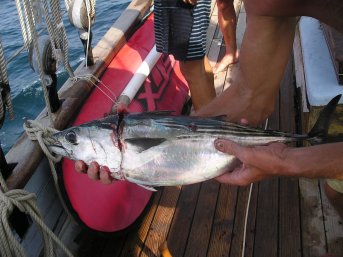
Jay, Mike and Ian were playing with sextants during the later part of the afternoon when Mike complained that there was something wrong with his sextant, since the shape of the sun had gone strange - then we remembered that the canal pilot had told us that there was the extremely rare occasion of an annular-total eclipse occurring on the 8th. We watched as the black disc slowly spread over the sun and everything went dark - apparently Panama was the best place to see this, and luckily we were there.
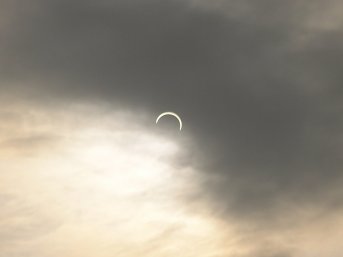
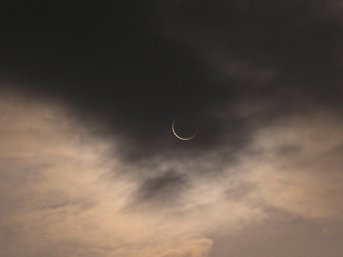
As the day got lighter again, we approached the anchorage in the Las Perlas islands and after some reef dodging (made more confusing with different charts telling us that different reefs and rocks were in different places) we anchored near 'Marie Tomasia', the boat that had been alongside us when we came out of the canal.
After a delicious barbie with the fat Bonito on it we had a few beers with our neighbours.
The next morning it was departure for Galapagos, but not before a walk ashore, where Robin did some quiet bird watching after he got rid of everyone else clambering about.
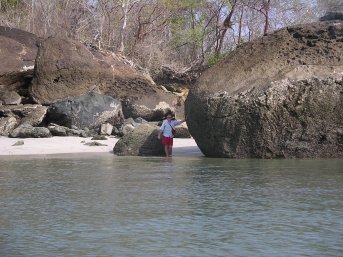
The vegetation was a huge difference to the tropical coconut palms that we were used to - the trees on the island looked more like something that would be seen in a British autumn, although that could probably be blamed on the fact that the island was very rocky, and that water was scarce in the dry season.
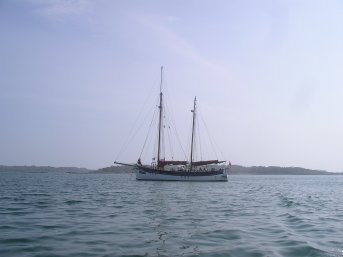
Then it was off to the Galapagos, 850 miles (approx 8-9 days depending on the wind), straight into a favourable but light breeze which allowed us to make 5 knots with just a small amount of engine help, with all sails up. The wildlife was extraordinary - the catalogue of sea animals seen for the day was: more than 15 turtles, 2 sharks, 2 schools of dolphins, a huge manta ray about 8 foot square that we nearly hit, and 2 five foot swordfish jumping out of the water.
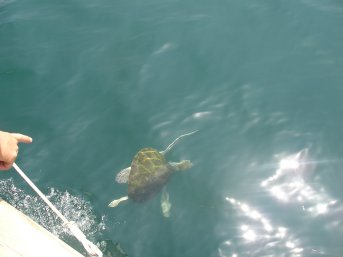
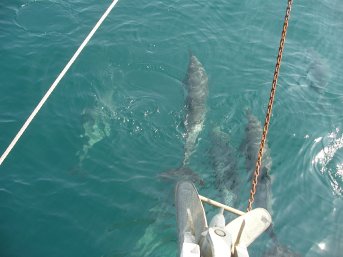
As the day progressed the wind died to nothing and we baked in the sun again, but all at once at about 5pm the wind got up again nicely and we could turn the engine off and sail along well. Towards midnight we went around the point at the edge of Panama bay, and with the current making the sea lumpy around the point, the number of large ships about requiring dodging (we counted 8 at one point), and the wind dying slightly we had to take everything down again and we motored on through the night.
The next day (10th April) was more overcast and a welcome relief from the heat and sun (we were down to 32C from 34C), but the wind refused to do anything except blow gently from precisely ahead of us.
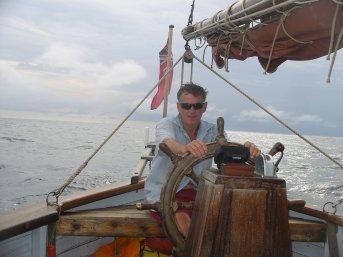
We continued motoring into the wind throughout the whole day on the 11th, and due to lack of inspiration on the sailing front there was much achieved. Rob fitted the new inverter that Ian had brought out from England, and Ian set to work carving a new lizard. Merryn and Rob both managed to fit a couple of exercises into the busy regime!
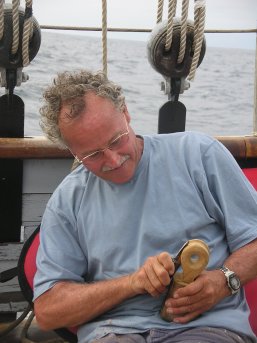
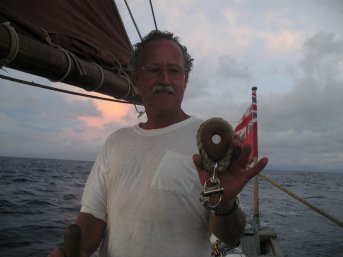
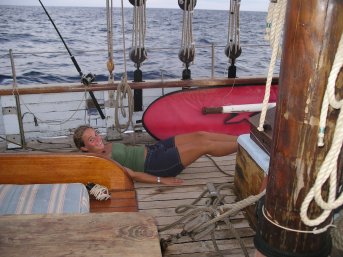
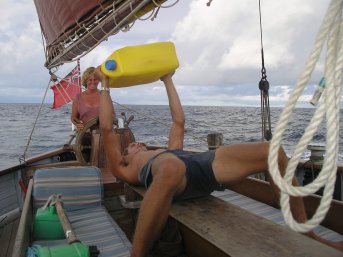
Gradually the sea became more and more lumpy due to wind and current against us - this didnít fair too favourably with Jay or Robin's stomachs, and slowed us down considerably.
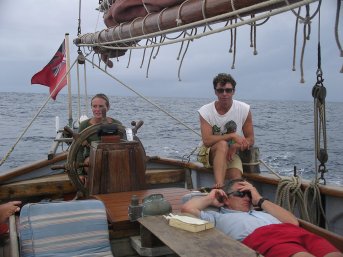
12th April, and the wind slowly came round to port, and we managed to sail close hauled on a port tack with the job, staysail, main and mizzen up, but unfortunately the wind wasn't strong enough to turn the engine off, and down came the sails that evening when the wind came back round too far for us to use it. We kept expecting the current to change from being against us - the Equatorial counter current would at some point change into the Equatorial current that would help our progress, but it seemed to have disappeared! We were caught between a rock and a hard place, unable to use the wind to sail north since we wouldn't get out of the counter current, and unable to sail south since we couldn't sail close enough to the wind to make it worth it.
The night of the 14th it got extremely cold, just to add to all the other oddities we thought that being 1degree from the equator it would be getting really hot. Our only conclusion, drawn from the fact that the water temperature dropped 4 degrees C, is that the favourable Humboldt current that travels north up the Peruvian coast bringing cold water from the southern ocean was bringing cold air with it. By the morning we were eating porridge as if we were experiencing an English winter!
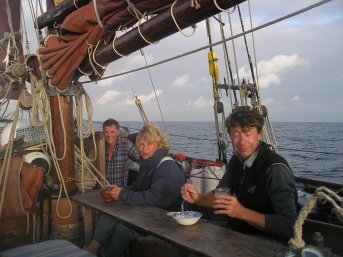
The only consolation was that the wind had finally moved enough after 3 days of motoring dead into the wind, and we were able to raise all the sails and make some progress close hauled, although the wind wasn't quite strong enough to turn the engine off. Robin was also finally feeling a lot better after 3 days of nil by mouth!
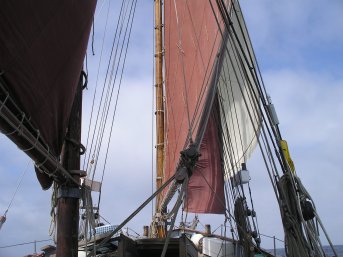
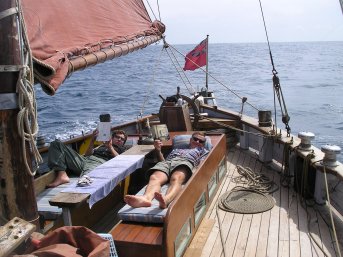
A few days more of the same, but with the current against us finally slowly turning into a slight push from behind. Mike cooked a hearty British bangers, mash and beans meal which kept spirits up!
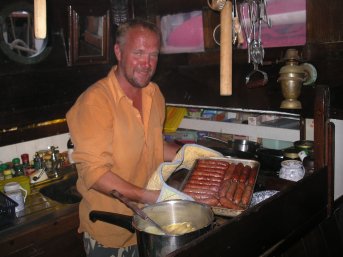
As we neared the Galapagos we approached and crossed the equator, a had a glass or two of champagne to celebrate.
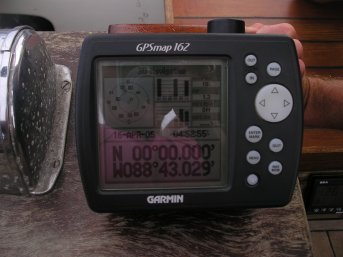
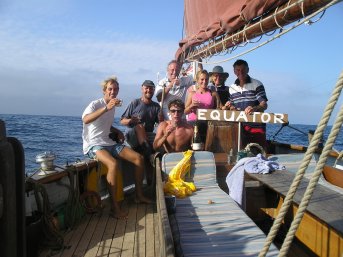
The next morning as dawn broke we had our first views of the Galapagos Islands as we approached from the North, and on the way in we circled Kicker Rock, a huge vertical-sided rock sticking out of the water.
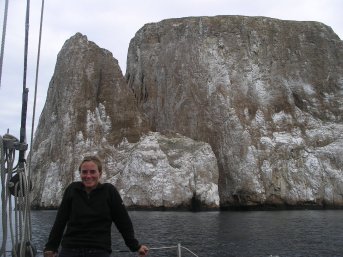
We dropped anchor in Wreck Bay, island of San Cristobal at about 11am and munched our way through a hearty fry-up before going ashore to have a look around. Seals were everywhere, laying on boats, rocks and just about anywhere they could have a good nap, and some were playing on the small slipway as we approached the town. We had heard many rumours about difficulties about cruising around and entering the Galapagos, since the Port Captains can be quite strict about permits and allowing sufficient time and freedom to see the islands. When we registered, the Port Captain in San Cristobal told us that we weren't allowed to visit any of the other islands and had to go straight to the Marquesas from there!
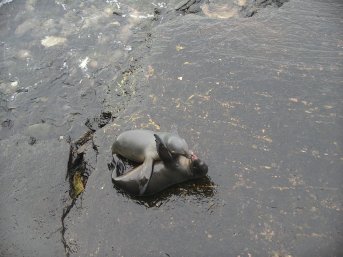
Despite our instructions, our route through the islands was as follows :
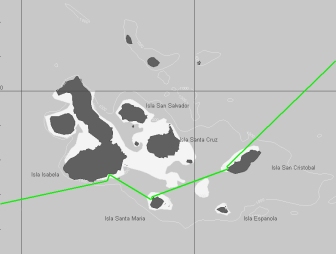
The next day, Rob and Mike got into the water and played with a couple of seals for a while around the boat. They were surprisingly tame and seemed to enjoy rolling around in the water with humans!
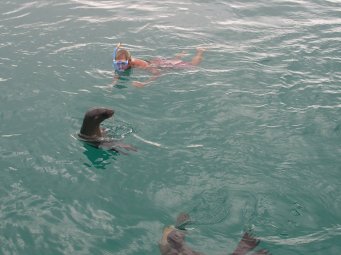
Noel and Jo arrived not long after us, so a few beers were necessary after a slightly misleading meal in a local restaurant, which was nonetheless very good and cheap.
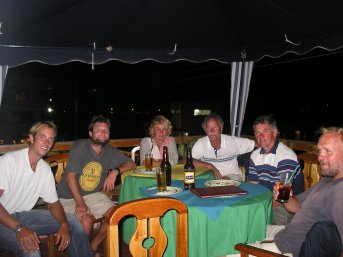
It was time to explore and so Jay, Robin, Ian, Stu and Merryn took an all-day taxi and did the rounds over the island, whilst Mike and Rob did some admin in town. The explorers were pretty pleased with themselves, having managed to get a taxi-pickup to drive them to all of the places of interest at a quarter of the price of a 'tour' being touted by the local conman, whilst Rob wasn't pleased by the website which took pretty much all day to get to work after the Panama Canal update went a bit wrong.
The explorers took the taxi to a turtle sanctuary where the San Cristobal Giant Tortoise could be found, and then they walked a mile to the coast on a cinder track.
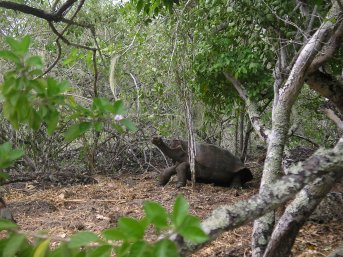
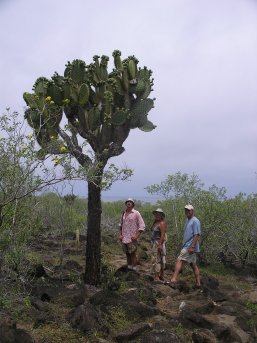
After a quick dip in the breakers, it was picnic time, which the tiny Darwinian finches seemed to enjoy, then it was back to the taxi to get to El Junco, the main volcano on San Cristobal. The climb up it took less than an hour, and the cooling mist was quite a relief!
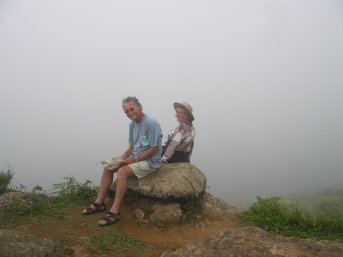
Meanwhile various seals had taken up residency in the dingy, and they looked so sweet that we didnít have the heart to throw them out, except when we needed to use it. They didnít make that much mess, only a few hairs and the odd bit of mucus to clean up!
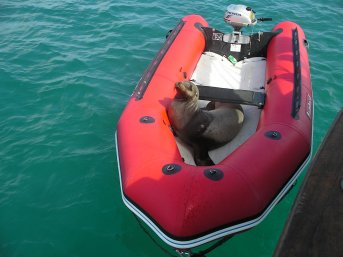
For the next couple of days Robin, Jay and Ian went for a few more walks, we filled up with diesel and some water, Rob changed the engine oil and fuel filters and then went for a regrettable surf which unfortunately involved ending up being washed up forcibly on some rocks, and resulted in several days of limping. We did however see some marine iguanas, although we only caught a relatively small one on camera.
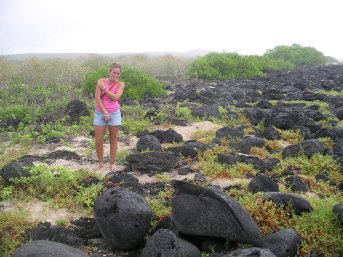
Having said goodbye to Ian as he flew back home via Equador, we went off to another small island, Florentina, where the port captain there was pleased to see us, and was happy to let us stay several days. Stuart went off for a huge walk 8km inland to climb the biggest volcano in the morning, with the intention of meeting us when we arrived up there later on in a local truck to see the only island water source - unfortunately the truck had a burst tyre and was unable to take us up there, so Jay and Robin had to walk up to find him and bring him back down! Meanwhile Rob, Merryn and Mike walked around the edge of the island and found a small island separated from the mainland at high tide, where there were several seals playing in the surf, and some nicely breaking waves.
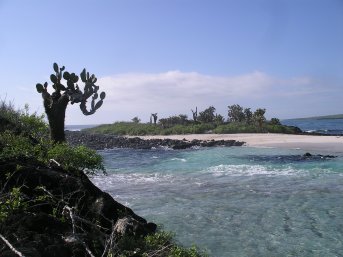
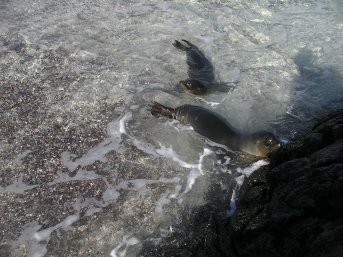
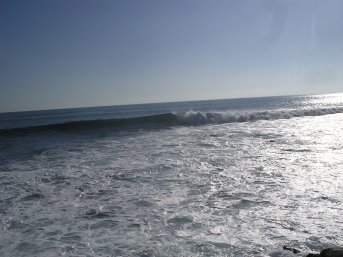
The next morning we took a panga, a local fishing boat, and went off to see the sights of the island -
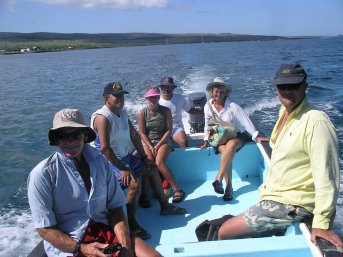
First stop was Post Office Bay, where since 1792 people have left letters in a barrel for visitors to take back to their own countries and post for them. Lately, visiting yachts have carved small wooden plaques and left them there too, creating a bit of a random sign post effect - this is said to be the only acceptable graffiti in the islands.
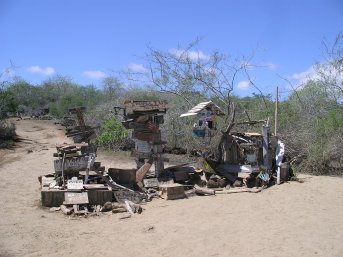
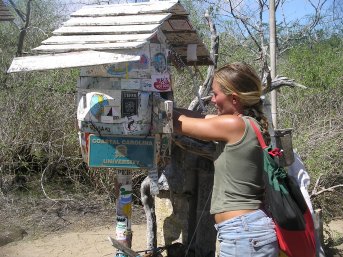
Further up the hill there is a lava tube, which is a hollow tube formed by the top solidifying over a lava flow, and then the lava flowing out into the sea. We climbed down into it and followed it down to sea level in the dark, until the beautifully cold water reached over our knees.
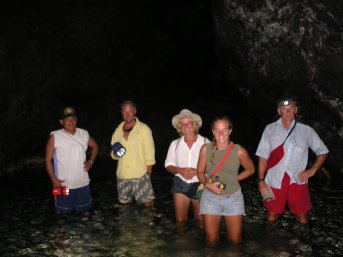
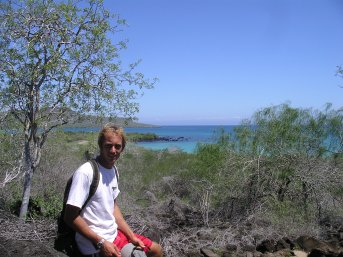
Getting back into the panga, we headed off up to the top corner of the island, and walked up to a lagoon with flamingoes in it, then carried on to the other side and had a paddle in the water at the beach. Merryn was very impressed by the colourful crabs climbing the rocks on the shore.
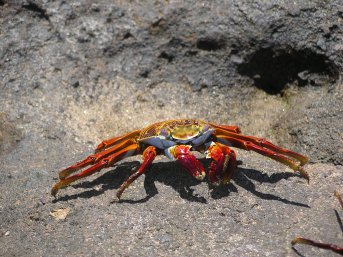
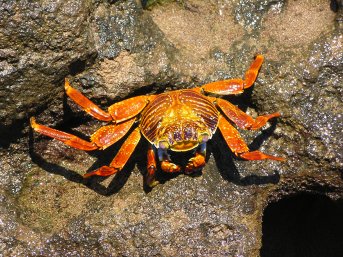
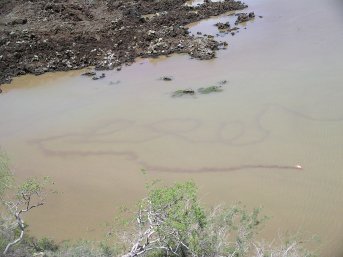
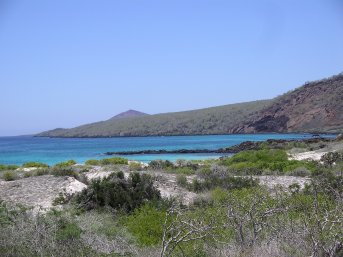
The final visit was to 'Devil's Crown', an old volcano cone in the sea, which had good snorkeling around the side and inside the cone.
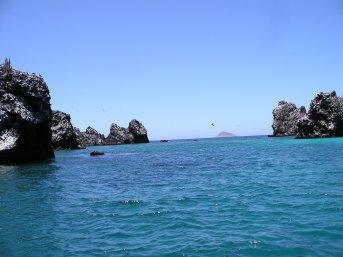
After a quick lunch on board, we were off again in the back of a Landrover to see the pirate caves near the only water source on the island, where water drips out of a rock layer about 8km inland. There was also a tortoise pen, where we saw yet more big tortoises.
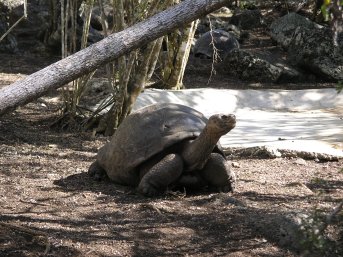
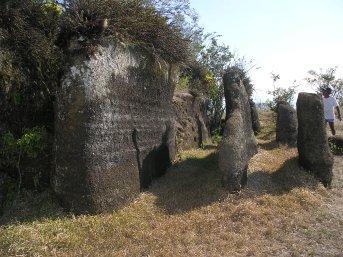
The next day we weighed anchor early in the morning, headed off to Isabella, the largest island in the group. Unfortunately, there was no wind al all, so we motored the whole way in the strong sunshine, but we saw a few whales nearby and a school of dolphins.
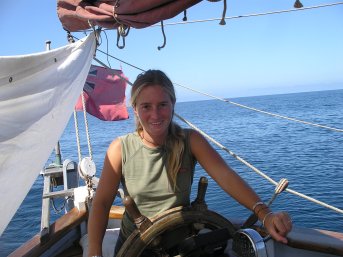
We arrived in Porto Villamil, Isla Isabella, that afternoon and anchored near lots of other boats in a small lagoon.
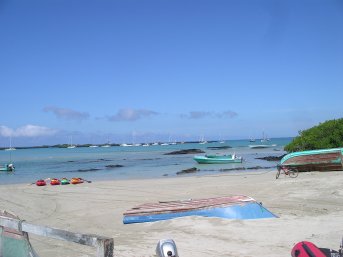
After exploring the town the next day, which had sandy streets and lots of nice houses on the outskirts, we went to a tortoise sanctuary where hundreds of tortoises, from tiny hatchlings to huge old ones a hundred years old, were kept.
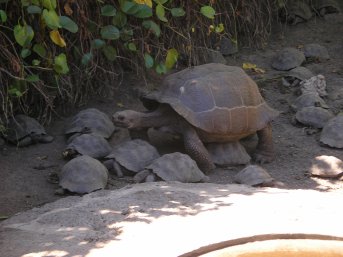
On the way back we couldn't resist a picture of a large marine iguana sunning itself on a wall near the beach.
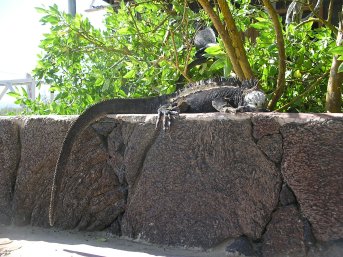
The next trip, starting early the next morning, was a ride in a pickup truck half way up the largest volcano, followed by a horse ride for an hour, then a walk down through the lava fields to the most recently erupted volcano. Jay, Mike and Stuart chose the horse option, whilst the rest of us walked a round trip of 12km each, but the cool breeze up the volcano made it less arduous.
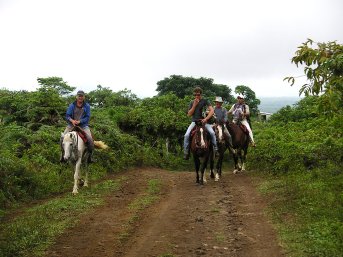
The horse ride took us up to and along the rim of the largest crater, the second biggest in the world, at six miles across - a wonderful view.
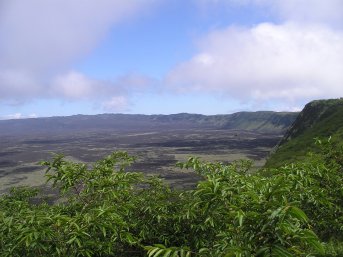
After a rest and a quick lunch, came the walk through the lava to the site of the most recent eruption, which luckily was 25 years ago.
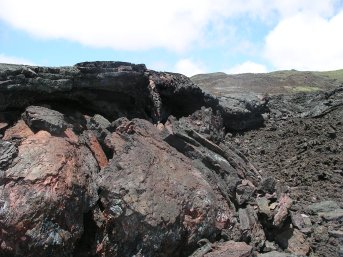
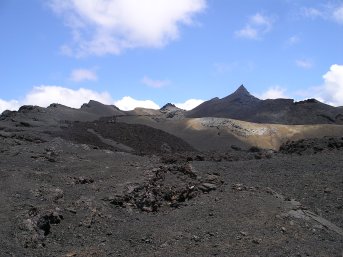
The view over the numerous craters and back down to the sea was fantastic, and after another two hours of walking we were back down at the truck to take us home.
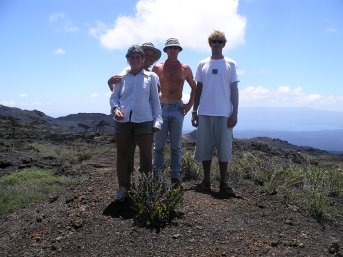
The next morning Rob, Merryn and Robin took the boat across to Santa Cruz, the capital of the Galapagos. Robin was flying out back to Quito and then on to Canada; Rob and Merryn went to get the all important passport exit stamp, and to withdraw some money for everyone, since Isabella has no banks!
We plan to spend the next week filling to the brim with diesel and water, buying our last stock of fresh fruit and veg, and finding last minute essentials before our longest sea leg of the journey, the 30 day sail to the Marquesas. There is little wind reported, although the trade winds and current should help us to a fair degree in our crossing. Hopefully, if we don't go mad during 30 continuous days at sea, we should arrive in Fatu Hiva sometime around the first week of June.
Back to previous section - Colon to Balboa (Panama Canal)
Forward to next section - Galapagos Islands to Marquesas
This page hit Count : 208560
This is the Lista Light Website, for the travels of the sailing boat Lista Light
Click here for text-version of site